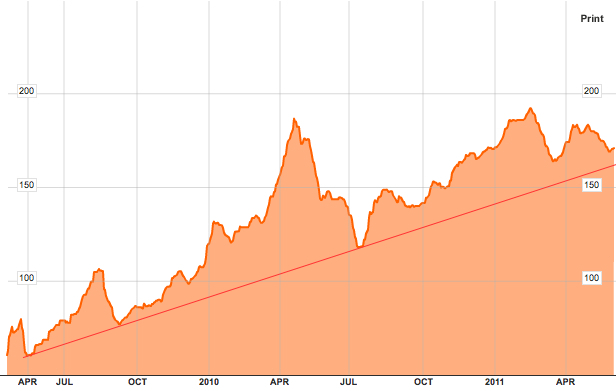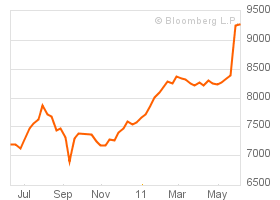
I won’t lie, the iron ore price has been making a goose of me for almost two years. At various points my forecast for big falls has almost been right but in total I have been clearly wrong. My prediction has been frustrated by tear away fixed asset investment in China, new market dynamics and Indian ore export bans. But there are some worrying signs that iron ore is looking rather toppy again now. The recent week has seen a little bounce but on the longer term chart, spot prices are approaching trend support:

Moreover, there appear to be big forces at work on the demand side. Back in February, China’s Iron & Steel Association (CISA) announced it was studying plans to create a strategic reserve of iron ore:
China will study plans to create reserves this year for iron ore and coal as national strategic resources, the China Iron & Steel Association (CISA) said.
As the world’s top buyer, China will invest more in iron ore mines overseas in a move to reduce its heavy reliance on imports from global iron ore miners Rio Tinto Ltd, Vale and BHP Billiton Ltd, it said.
“China should change its vast foreign exchange reserves into state reserves of resources that we rarely have but badly need,” Luo Bingsheng, who this month stepped down as vice-chairman of CISA and is now a special advisor for the association, said.
The idea clearly has merit for the Chinese in their interminable battle with big Australian miners and the push towards a floating market or spot pricing for iron ore. A strategic reserve of sufficient magnitude creates a new price-making pressure point on the demand side of the equation because it consolidates the power of many disparate steel makers into the hands of whoever it is that controls the reserve. That is not to say that it marginalises supply and demand forces, but it does certainly add a new weapon to the demand side in negotiations.
For example, you may recall that CISA used to represent the majority of Chinese steel makers in negotiations over annual ore pricing contracts with BHP and Rio. However, during the big price spikes (in the spot market) in 2008, the Australian miners pushed trough very high contract price rises (and tried to merge to further consolidate their negotiating power). When the spot market collapsed during the GFC, many Chinese mills walked way from their contracts and instead bought ore more cheaply on the spot market. However, as prices recovered, the annual contract violations of the Chinese gave BHP and Rio the moral high ground to push through shorter term contracts, which now reflected the rising spot prices more quickly. Chinese steel-makers were effectively splintered, the annual contract system that provided discounts was broken, and BHP and Rio made hay.
A strategic reserve helps restore some of the former concentration in buying power because it might, for instance, be run down at times when contract negotiations or market pricing runs too hot. Put simply, once in place, a strategic reserve is a new source of supply controlled by those on the demand side and can weigh permanently on prices.
Now, I’ve seen nothing about CISA or anyone else actually acting on the building of this reserve since the idea was mooted. But let’s take a look at what’s happened to Chinese port inventories of iron ore in the past year:

And compare that with the last five years:

Since 2008, inventories have more than doubled. I don’t want to sound too conspiratorial. This is probably all natural causes, just a steady build of supplies. The latest climb is so steep it rather looks like a statistical revision. Also, China did increase steel production between 2009 and 2010 by 9.3% and by roughly 25% since 2007. If that doesn’t quite seem to account for it, we might finger hoarding or just slower than anticipated demand. Any input into these ideas is welcome.
Whatever it is, it has some analysts speculating that the iron ore glut is coming sooner than the 2014 timeline that is gospel in Australia. From Forbes today:
As China builds its inventories and global production rises from heavyweights like Vale, Rio Tinto and BHP Billiton, we expect average prices for iron ore to drop off in the coming years. If these prices drop more than we expect, there could be downside risk to our $42 price estimate for Vale, which is roughly 30% ahead of market price.
The ferrous minerals division, which accounts for 63% of the company’s value, is by far the most valuable division for the company. Currently, more than 75% of the company’s profits come from this division. This division includes vale’s iron ore, iron ore pellet, pig iron, manganese and ferroalloys shipments, with China being its largest consumer with 60% market share.
We expect the iron ore prices to fall by approximately 30% in 2011 and 9% the next year, after which, prices may settle down at around $100/ton levels. This could weigh on company’s stock price.
Over Supply Concerns
The continuous build up of iron ore inventories in China, the world?s largest producer and importer of iron ore, over the past few years will help it reduce its reliance on external iron ore and price shocks. Also the three largest iron ore miners globally Vale, BHP Billiton and Rio Tinto are investing heavily in expanding their mining production to meet anticipated demand from emerging markets.
In addition, the announcement by the Chinese Ministry of Land and Resources to invest CNY 30 billion in ore seeking tasks beginning 2011 will also contribute to oversupply in the iron ore market by 2012.
As impressive as 30 billion yuan is, it can hardly boost ore supply in one year (see Troy McClure for more criticism of this article). Moreover, as Phat Dragon argued yesterday, China’s program of fixed-asset expansion is nowhere near done. Longer term, demand looks likely to remain strong and, even if prices fall, volumes shouldn’t.
However, what is plausible is that as China continues to tighten monetary policy and as the world economy slows, we might see an iron ore inventory cycle, either deliberately or as a part of natural slowdown, that is exacerbated by the gigantic pile of red metal sitting in China’s ports.
That is a scenario in which we might see $100 iron this year.
This is all quite speculative I realise but if someone can throw more light on the provenance of that inventory pile, I’m all ears.

